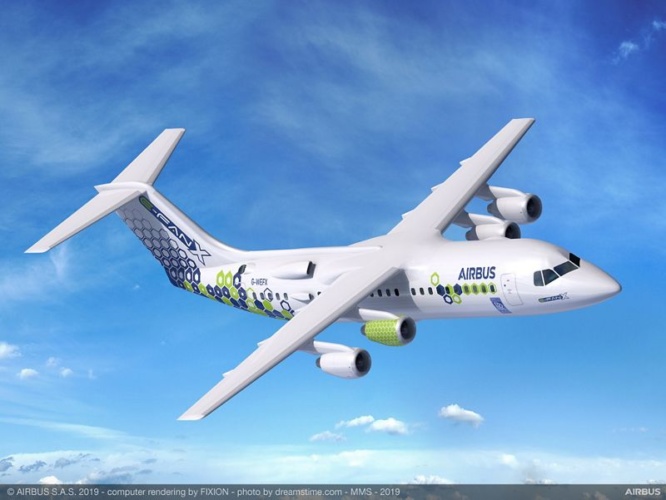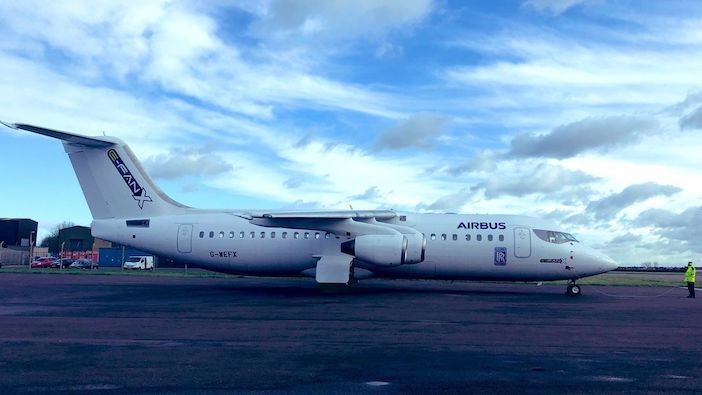
The flight from Cranfield University in the UK of the BAe146 RJ100 was conducted on February 25. The aircraft is to be modified to accommodate a hybrid-electric propulsion system supplied by Rolls-Royce and flown in that configuration next year.
The E-Fan X will be the latest iteration of Airbus’ E Fan series of aircraft, the first of which was developed in 2014. The project to develop the latest technology demonstrator is a partnership between Airbus and Rolls-Royce that is receiving £58m (US$74m) of funding from the UK government.
Siemens, Rolls-Royce and Airbus join forces on hybrid electric aircraft
Archive Interview - former Airbus CTO Jean Botti
Bob Gilfillan, chief engineer E-Fan X at BAE Systems Air said, “The aircraft has been under our control since October. There were some test flights conducted then and at the end of February to baseline the performance, so that after it’s modified we can assess the impact of the hybrid-electric system accurately.
“When we are using our Design Organisation Approval we are usually in charge of the program, but this case is unusual in that we are supplying that supervision and responsibility of the aircraft as a service to Airbus.”
BAE Systems’ involvement is focused on making the modifications to the BAe146’s systems and structure to integrate the hybrid-electric system. This includes changes to the hydraulic and electrical systems as well as structural modifications.
As a demonstrator, the aircraft’s certificate of airworthiness is no longer valid and BAE Systems are providing the permit to fly under delegated approval from EASA and CAA. The aircraft is currently being supervised by specialist BAe146-maintenance provider Avalon Aero at Cranfield and will remain there until October this year.
The move at this time will be necessary because after the modifications the aircraft initially has to be flown without the hybrid system switched on. It is capable of flying on three engines but requires a longer runway than is present at Cranfield University to do so.
Test flights of the modified aircraft are being conducted by Airbus Test Operations. The main test flight program is expected to start out of Toulouse, France at the end of 2021 and last around six months.

As well as looking at handling and aerodynamics in different environmental conditions, the flight test instrumentation will include equipment to closely measure the performance of the electrical system and will record current and voltages.
The modifications to the aircraft will be done within the UK. The major modification will be engine number three, which will house a 2MW electric propulsion unit (EPU), swapping the aircraft’s current turbine for a Rolls-Royce-developed electrically driven fan and motor housed within the existing engine’s cowling.
The EPU will be powered by a Rolls-Royce AE 2100 gas turbine-driven 2.5MW generator at the rear and battery system located at the front of the aircraft. According to Rolls-Royce the system will be the world’s most powerful flying generator when airborne.
The hybrid-electric system, including the gas turbine, generator, power distribution system, motor and EPU are currently being tested at Airbus’ Test House in Ottobrunn, Germany before integration into the BAe146.
Other modifications are being made to the aircraft to mitigate the expected heat that is produced by the new hybrid-electric system inside the aircraft. These changes include the addition of heat exchangers, air intakes and exhausts on the fuselage.
Gilfillan said, “The three main concerns with hybrid-electric systems on aircraft are battery safety, installing the high voltage system in a confined space and the waste heat from the high voltage system, which is all produced in the wrong place. In this aircraft its being removed and dumped outside, but in future designs something better will be done with it.”
Airbus also recently completed wind tunnel testing on a 1:8 scale-model of the E-Fan X at its Filton low-speed wind tunnel in the UK. The wind tunnel has a test section measuring 3.65 x 3.05m and can produce airflow at speeds of up to 216mph.
At a 1:8 scale, the E-Fan X was tested with a wingspan of over 3m. The model modified and used for the test was the same as was used in the BAe146 RJ100’s original development in the early 1980s.
“The E-Fan X is an aircraft demonstrator, so it’s not optimised for aerodynamic design,” said Oliver Family, Airbus head of overall aircraft design, E-Fan X. “But to fly the demonstrator safely and efficiently, the aerodynamic impacts need to be fully understood.”
“The only change we discovered during the test program is that we need to modify the porosity of some of the devices inside the ducts to ensure they relate correctly to the full-scale E-Fan X model devices,” said Paul Gingell, Airbus wind tunnel test engineer.
This article originally appeared in The Engineer's sister publication Aerospace Testing International




April 1886: the Brunkebergs tunnel
First ever example of a ground source heat pump?